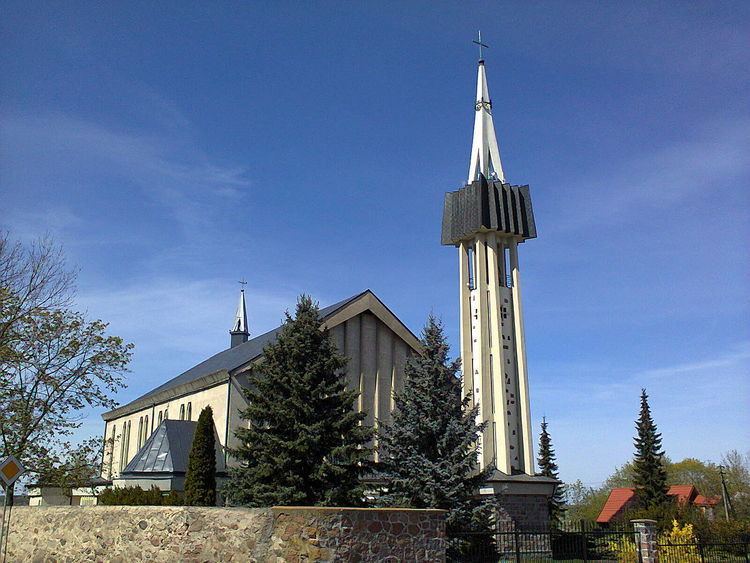Country Poland Local time Thursday 7:58 AM | Population 1,267 | |
 | ||
Weather 1°C, Wind NE at 2 km/h, 83% Humidity | ||
Radziłów [raˈd͡ʑiwuf] is a village (formerly a town) in Grajewo County, Podlaskie Voivodeship, in north-eastern Poland. It is the seat of the gmina, an administrative district called Gmina Radziłów. It lies approximately 27 kilometres (17 mi) south of Grajewo and 61 km (38 mi) north-west of the regional capital Białystok. In 2007 the village had a population of 1,267.
Contents
Map of Radzi%C5%82%C3%B3w, Poland
History
The history of Radziłów is closely connected with the history of Masovia Province from before the Partitions of Poland. The first settlers arrived in the Middle Ages and began clearing the impenetrable forest. Masovian Dukes, who owned the area, issued the rights to enter the forest and harvest it. Among the first settlers were bee-keepers, fishermen, hunters and loggers, who sold honey, wax, fish and lumber to neighboring towns, Wizna and Goniądz. The lumber was also transported via Biebrza and Ełk river waterways to Gdańsk.
The founding of the city took a long time. Radziłów was formally established by Prince Konrad III, with Kazimierz III, Bolesław V and Janusz II, who gave it the city rights on May 9, 1466. The town began to flourish in the 16th century. Located at a trading route between Wizna and Wąsosz, it became a commercial center for bakers, shoemakers, tailors, butchers, blacksmiths, wheelwrights, cooper-makers and potters. The main square in Radziłów at the time (180 m × 120 m in size) was bigger than in Warsaw (70 m × 94 m) and in Płock (140 m × 70 m) and held two weekly markets, on Monday and on Sunday (from 17th century on) as well as a fair on Wednesday added by king Władysław IV in 1641. The majority of inhabitants lived off farming.
During the partitions of Poland, after the suppression of the 1863 January Uprising against Russia, the Tsarist authorities changed the administrative divisions of Congress Poland placing Radziłów in the Łomża province. In 1869 the town was stripped of its town charter and became the village; however the population was steadily increasing due to Russian repressions against Jews some of whom found refuge in the area. The Jewish merchants expanded local trade, established breweries, small craft and various services. Following the rebirth of Poland after World War I, two new public schools were established employing ten teachers, and two Jewish schools.
In 1940, the town had a population of 2,865 people, of which 500 were Jews.
World War II atrocities
During the German invasion of Poland, the Nazi 3rd Army entered Radziłów on September 7, 1939. The area was transferred to the Soviet Union at the end of September in accordance with the German–Soviet Boundary Treaty and remained in Soviet hands until Operation Barbarossa in July 1941. Polish administration was dismantled and replaced with local Jews some of whom abused their new position in relationships with Poles, causing other Jews to condemn this. Soviet-armed Jewish militiamen helped NKVD agents send Polish families into exile. Soon after the German attack on USSR, a few hundred Jews were massacred in the town. Many were shot, but most were herded into a barn and burned alive on 7 July 1941 by the Gestapo Einsatzgruppe B (Zichenau-Schroettersburg) under SS-Obersturmführer Hermann Schaper.
The war crimes committed by Schaper were investigated in 1964 by the German Judicial Centre for Prosecuting Nazi Crimes in Ludwigsburg. The prosecutors called a key witness, the German Kreiskommissar who named Hermann Schaper in the course of Birkner's investigation. Schaper was charged with personally directing the Einsatzkommando responsible for the mass killing of Jews in the city.
"The evidence collected by the West Germans, including the positive identification of Schaper by witnesses from Łomża, Tykocin, and Radziłów, suggested that it was indeed Schaper's men who carried out the killings in those locations. Investigators also suspected, based on the similarity of the methods used to destroy the Jewish communities of Radziłów, Tykocin, Rutki, Zambrów, Jedwabne, Piątnica, and Wizna, between July and September 1941 that Schaper's men were the perpetrators." — Alexander B. Rossino
During his investigation Schaper lied to interrogators that in 1941 he had been a truck driver and used false names. The case against him for the murder of Jews in Radziłów was remitted by the prosecutor in Hamburg in 1965. His case was reopened in 1974, when the Nazi German administrator, Count van der Groeben testified that indeed Schaper's men conducted mass executions of Jews in his district. In 1976 a German court in Giesen (Hessen), pronounced Schaper guilty of executions of Poles and Jews by the kommando SS Zichenau-Schroettersburg. Schaper was sentenced to six-years imprisonment, but was soon released for medical reasons. In 2010 Polish Institute of National Remembrance conducted its own investigation of the Radziłów crime and requested access to the documents of the Hamburg case but according to the German side, these were most probably destroyed after his case was terminated. The IPN investigation was suspended due to lack of hard evidence, and only a short statement issued about its initial objectives.
